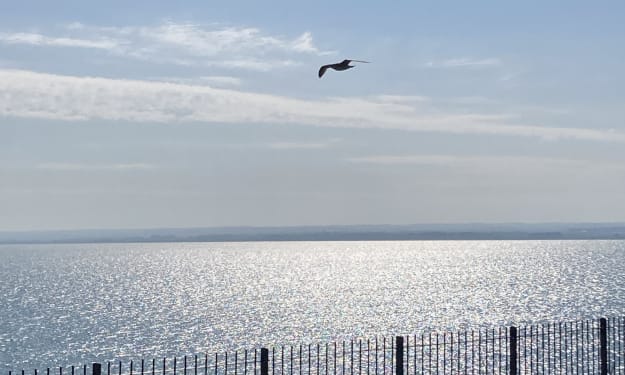(British) Parakeets
Notes on an invasive species

When I moved from the lovely countryside to an urban town I could be forgiven for thinking I was waking up in a warmer climate when my eyes and ears landed on the brightly coloured and ever so loud squawking of the (British) parakeet. In fact I’m sure that many a visitor to the Kent coastal town of Ramsgate (and surrounding areas) have pondered exactly this when waking to these beautiful birds outside their window, who live abundantly in their urban jungle.
Long have they been residents of this town on the south east coast and long have they been growing in numbers. They have made this little corner of the UK their permanent residence.
Once abundantly living in the King George VI park between Ramsgate and Broadstairs they now reside all over the town and are often found hanging on telephone lines or on rooftops in the St Lawrence area as well as in the large trees dotted around between the houses.
These ring-necked parakeets are not native to the British isles, in fact their home is the tropical countryside stretching from Sub-Saharan Africa and the foothills of the Himalayas. Slightly warmer than the climate we here in the United Kingdom generally enjoy. However, one could take a guess that with climate change raising the general temperature worldwide these birds have met us head on and acclimatised themselves to our corner of the globe.
Despite their origins Parakeets are able to cope with the cold temperatures of the British winter. Though they are mostly concentrated in South-East England. Perhaps because of the generally warmer weather the south of the country boasts. Although reports of colonies in Glasgow, Sheffield, Birmingham, and Manchester as well as others around the country have also been reported in recent years. Suggesting that either they are enjoying the colder temperatures or the temperatures are rising at an alarming rate.
The urban areas they choose to live are in or around are local parks, gardens and any surrounding orchards where food is in abundance throughout the colder months.
They feed on a variety of foods such as fruit, nuts, seeds, berries, grain and household scraps. Local garden feeders can be a popular place for these birds in winter especially when the competition for food is higher. However, they do have a tendency to scare other smaller birds away much to the disappointment of the homeowners hoping to see how many varieties of bird will flock to their little corner of paradise. Perhaps this is why I have seen less smaller birds in our garden as these flamboyant birds are often seen overhead, especially on lighter, warmer evenings.
These beautiful green birds have previously been featured on BBC Springwatch in 2018 and continue to be a popular sight. But where did they come from?
They are described by the RSPB as being the UK’s only naturalised parrot, and began being noticed in the 1960’s.
There has been much speculation over the years as to how these wild parakeets became naturalised here. Two of the most common suggestions are firstly that some ringnecks escaped from Shepperton Studios in Surrey during the filming of ‘The African Queen’ in 1951.
Secondly, and my personal favourite is that Jimi Hendrix released a breeding pair in the late 1960’s. Research suggests that this was to inject psychedelic colour into the streets of London.
However, as always reality brings me back down to earth as I delve deeper into these stunning green birds. Hazel Jackson, the evolutionary biologist at the University of Kent told The New Statesman in 2017 that more likely there have been numerous introductions. It is estimated that there are more than 32,000 of them in the UK, making them one of the UK’s fasted growing bird populations.
Scientists writing in the Journal of Zoology have also used geographic profiling to disprove claims that our British Parrots grew from a single release at a specific time. They believe that there have been multiple releases of these birds, both accidental and intentional over a large amount of time. In fact there are newspaper reports dating back to the Victorian era and a possibility of a large release of pet parrots in 1929 when the media reported on ‘parrot fever’ (psittacosis) infections which could have scared owners into releasing their birds.
I have and always will be a country girl, and often feel like a duck out of water in the middle of a noisy town. Perhaps that is why I find the parakeets so interesting. Like me they have been taken out of their natural environment and found themselves somewhere completely new. Since that first day they like me they have adapted and grown to love (accept) their current surroundings. I feel almost like they are one of my spirit animals, teaching me to thrive in different environments to the one I would prefer. They are the perfect example of working with what you have and adapting to suit your current situation.
Of course these pretty birds are indeed very noisy, which is not something I’m fond of, but I accept this as they have accepted this new home they have found themselves in. Yes they are lacking the beautiful tones that we here in the United Kingdom are used to from
our wild birds. The squawking of these flights of fancy are enough to make you cover your ears when close by so, your not likely to miss them if you go looking for them. But, with their rich British history already building how can we not give them a place in our hearts next to the Christmas Robin and Spring Nightingale?
As long as we wear earplugs I see no reason to not enjoy these miraculous birds who have grown to love our great British weather and provide our eyes with cheerful colour on a bleak spring day. As long as they don’t do too much damage in the process.
About the Creator
Charlotte Fay
Rambling outdoors & writing about it. Love a good adventure. Passionate about holistic wellness & the natural environment. Studying a Wildlife Ecology & Conservation Degree. I also love to write about a variety of subjects that interest me.






Comments
There are no comments for this story
Be the first to respond and start the conversation.